IJN Akitsushima was a seaplane tender of the Imperial Japanese Navy launched in 1941 and completed in 1942. She was tailored as a large floatplane tenders for long range missions, and was even capable of launching them thanks to her massive catapult and facilities. She was designed from 1938 with a very precise goal in mind, to operate the Kawanishi H6K, only aircraft capable of bombing Pearl Harbor directly from the Marshall Islands. This post is thus coupled with the study of the Kawanishi H6K. The ship replaced absent facilities for flying boats there and to gain time in early 1939, the IJN requisitioned and converted the oiler Kamoi, into a dedicated seaplane tender, with however no housing nor repair facilities. She was purely a replenishment ship, loaded with aviation gasoline, bombs and torpedoes. Her service was short, as she was sunk in September 1944 off Manila by aircraft of TF 38. Originally she was the head of a full class, comprising also IJN Chihaya, also made at Kawasaki Shipbuilding, Kōbe Shipyard but never completed after only a few months of work, and the unnamed 5031, 5032 and 5033 all cancelled on 5 May 1944. Akistushima was also one of the rare IJN warships ever camouflaged, in a complex pattern reminiscent of WW1.

Development
The Imperial Japanese Navy, notably under the influence of the naval air power proponents, explored scenarios of attack against American assets in the Pacific, being the only real threat to the IJN advance in Asia, with the much reduced local RN assets, RAN and Dutch forces estimated of lower importance and to be dealt with peace meal. The US decision to move the bulk of the fleet to Pearl harbor in 1940 was preceded by the fact that even with lass warships present, this was the go-to advanced base in the pacific, and US warships based on the West Coast were supposed to all gather here in case of war. The 1940 decision as a response to the intensity of the crisis after the 1937 attack on China, ongoing war, and Indochina affair, made only more obvious that Pearl Harbor was, with the Panama Canal second the two primary objectives of the IJN.
Long range attack Context
Many scenarios of attack were developed, and the final attack was a combination of both air power and midget submarines. It must be recalled however the 1st Air Fleet or “kido butai” informally as a mobile task force invented by Yamamoto was created after the US decision and commanded by under Vice-Admiral Chūichi Nagumo in 1941. However back in 1937, the idea of gathering six fleet carriers for such an attack seemed far fetched. Instead, one likely scenario was to bomb Pearl Harbor after a long distance flight from the Marianas. At the time, these islands were part of the Pacific network of Islands granted to Japan for their participation in WWI with the entente powers, and take over forcibly from the Germans in 1914. These bases were never developed sufficiently. Only Guam was large enough to offer some ground to install an airfield, but work progressed slowly an anyway, there was no bomber in the IJN capable of such range, which was 6300 km or 3919 miles at the time.
The flying boat tender option
Under Yamamoto the air branch was pushed hard and unlike in the US, the Navy branch wanted its bombers and developed its own models, such as the Mitsubishi G3M developed from 1933 already, and later its replacement the G4M better known later by the allies as “nell” and “betty”. Still, the G3M range was 4,400 km (2,700 mi, 2,400 nmi), not nearly enough. There was still a 2,000 gap to be covered. That’s why another solution seemed obvious, the development of a long range seaplane that still act as bomber. There was for this a Navy requirement in 1934 for a long-range flying boat. The company chosen was the most thought after, a specialist of the type, Kawanishi kо̄kūki (established 1920). We will not dwelve in detail on the genesis of this model detailed here. (link incoming)
The H6K was just an improvement over the 2-engined G3M, capable of 4,797 km (2,981 mi, 2,590 nmi) and of 6,080 km (3,780 mi, 3,280 nmi) in ferry range. The latter was probably the most interesting option, as if these flying boats were supported mid-way by a fleet of tenders, they might be capable of such a bombing, provided they could locate the fleet at their return using radio direction.
In any case, debates came up in 1937-38 as an option alongside an operation led by submarine-carried floatplanes on Panama. In 1939, the idea of a massive aircraft attack gained traction and became a priority. In 1939, still budget was allocated to the floatplane tender option, at least to be stationed in the Marianas and offer supplies on their way to other areas of operations.
Final Design development of the class

The 17,000t seaplane tender Kamoi, overhauled in 1939 with flying boat tending facilities. By November 1940, she was assigned to the 24th Air Flotilla. She could operate 22 Nakajima E4N or 12 Yokosuka E5Y but no large seaplane.
Early in 1939, the IJN converted the existing oiler Kamoi into a seaplane tender. The base ship had advantages, notably her massive internal hold structure perfect to carry goods. However space was lacking to establish a workshop for the type of aicraft she was planned to serve as supply ship, to allow a full squadron of seaplanes to extend their range mid-way to the Marianas to Hawaii but not able to repair seaplanes, just doing basic maintenance (oil supply notably, basic fixes). The deck was deemed large enough to accomodate a single floatplane, picked up by a crane or a modified poop with slope and winch (an option not retained).
The IJN therefore planned two types of seaplane tenders in 1939 actually, included in the Maru 4 Programme (4th Naval Armaments Supplement Programme, 1939). This planned a 10,000-ton class flying boat carrier, the other option being a 2,400-ton class flying boat tender. None passed the assessment by the Ministry of Finance, as competing programmes inside the navy had better traction. These two basic plans were presented again in Maru 5 Programme (1941). Neither of these plans turned out to be adopted but instead the IJN took the smaller 2,400 t tender and scaled up it to 3,500-ton, making it a full class with five vessels planned.
At that stage, no concerns were given to treaties anymore, and yards were busy building new ships and converting others, so availability was reduced for competing programmes. In its final draft, the ship chosen was to maintain, repair and supply seaplanes. In that phase the bow-up trim and slope option was deemed too long to setup and the plan was cancelled given how low was the Akitsushima class in the general 1941 naval plan. She was to keep her initial hull while being equipped with a 35-ton crane to at least being capable of lifting aboard any flying boat in service in the IJN and supply/load/maintain it, which was near-impossible if the latter was in the water. The IJN changed design many times however, and the final draft ended up with a displacement increased by 1,000 tons.
Hull and general design
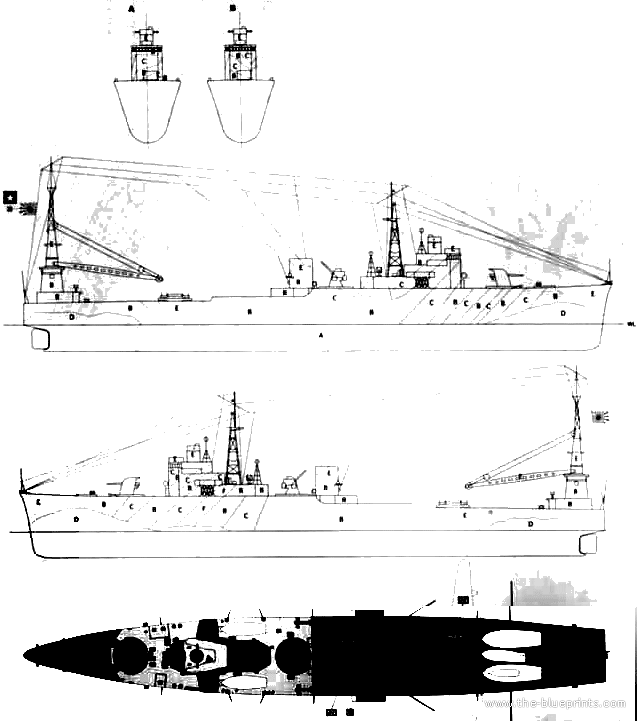
The IJN Aitsushima was therefore a tailor-built seaplane tender, with a proper military hull. In some points she recalled the Katori class school cruisers that were built at the same time. She looked compact, beamy, with a tall freeboard forward, 50% long forecastle, lower deck aft deck with all the necessary facilities and deck to handle a massive seaplane. For stability, there was plenty of draft as well at 5.4 m (17 ft 9 in). The final design was registered at 4,650 long tons (4,725 t) standard and 5,000 long tons (5,080 t) declared for trial. Real tonnage was in excess of 5,700t when fully loaded (see the 780t payload).
The hull measured 114.8 m (376 ft 8 in) overall and 113 m (370 ft 9 in) at the waterline with a traditional warship bow, smooth clipper ending with the traditional chrysantemum flower.
The Beam of 15.8 m (51 ft 10 in) gave her stability but represented a 7,21 ratio, not favourable to speed. But between her high freeboard and generous rudder she was stable and agile. It lmust be added that at this point she had no armour protection at all.
The general design comprised a forward “military” part on the forecastle with the two twin 5-in dual purpose guns fore and aft of a tall and boxy three-tiered and faceted bridge, topped by the main fire control telemeter, and a lattice tripod supporting the main radio gear. There were two antennae located on the bridge’s steps and beacons to guide back the floatplanes as well.
These ships had a single funnel amidship located behind the forecastle cut.
The lower all metal rear section, covered with anti-slip plates, was divided between a resting cradle for large floatplanes (when designed, for the H6K, but they were adaptable and served also the H8K). There were four service boats (two abaft the bridge, two aft close to the stern) and rafts for the crew of 545, not including the air crews, as space lacked to house them. But the most sticking point was of course the immense crane aft (see later). And there was a transom stern, still rare on IJN vessels. Overall this made for a very recoignisable silhouette.
Powerplant
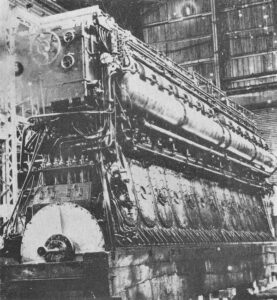 The Katori class cruisers had many similarities, albeit they were shorter and a bit beamier, but were heavier and powered about the same. They had 2-shaft geared turbines, plus diesel motors and 3 Kampon boilers for 8,000 shp (6,000 kW), 18 knots, range 9,000 nm. This was a standard arrangement. IJN Akistushima however benefited from the latest in diesel technology and needed one able to reduce its size internally. The class indeed had a much simpler powerplant with just four Kampon Mk.22 Model 10 diesels, essentially submarine diesels crancked together on two shafts for a total of 8,000 bhp (6,000 kW). This gave the advantage of redundancy, for a still generous top speed of 19 knots (35.2 km/h; 21.9 mph) if needed (better than the Katoris !) but a range estimated lower at 8,000 nmi (15,000 km; 9,200 mi) at 14 kn (26 km/h; 16 mph). It does not seems this compact powerplant, enabling extra space for stowage, posed any reliability issues.
The Katori class cruisers had many similarities, albeit they were shorter and a bit beamier, but were heavier and powered about the same. They had 2-shaft geared turbines, plus diesel motors and 3 Kampon boilers for 8,000 shp (6,000 kW), 18 knots, range 9,000 nm. This was a standard arrangement. IJN Akistushima however benefited from the latest in diesel technology and needed one able to reduce its size internally. The class indeed had a much simpler powerplant with just four Kampon Mk.22 Model 10 diesels, essentially submarine diesels crancked together on two shafts for a total of 8,000 bhp (6,000 kW). This gave the advantage of redundancy, for a still generous top speed of 19 knots (35.2 km/h; 21.9 mph) if needed (better than the Katoris !) but a range estimated lower at 8,000 nmi (15,000 km; 9,200 mi) at 14 kn (26 km/h; 16 mph). It does not seems this compact powerplant, enabling extra space for stowage, posed any reliability issues.
Armament
2×2 127 mm L/40 Type 89 AA guns
The main armament of the Akitsushima class ws located forward, either side of the main bridge. The forward twin mount was fully enclosed in a forward shield, but the aft one was less protected and only had its gun cradle open. These weighted 3,1t, for a 5 m barrel, firing a 23.45 kgs round to 8-14 rounds per minute at 9,440 meters (30,970 ft) at 90° and 14,800 meters (48,600 ft) against ships. More.
Type 96 25mm AA guns
Two twin mounts installed on the wings of the bridge, supported by lattice structures. In 1944 two more, triple 25mm/60 96-shiki (or type 96) AA guns were added, probably on deck forward.
Specs on the weapons encyclopedia.
Depth Charges
In addition to the four paravanes located either side of the forecastle break, on the upper and lower deck, there was some decent anti-submarine armament, namely six free-falling Type 95 depth charges located close to the stern and one Type 94 depth charge thrower (Y-gun) also aft.
Air Facilities
There was no resident air group. Instead the Akitsushima class could have one seaplane in anchorage, resying on deck with a massive crane at the stern and stowage deck for maintenance.
The crane was a simple boom style one with pulleys combinations and a gantry designed to lift the seaplane on its dorsal attachment points, balanced. The cra, comprise a small operator post, a solid base with superstructure (the axis was planted at the base of the transom stern below, just over the rudder) and an aft mast rested on top, taller than the bridge’s foremast.
Once the sepalane hull rested on the central pads, its underwing floats were not accessible, being over the sea. It’s no clear how the crew was able to access the underwings to attach depht charges and bombs or torpedoes, as this needed rails and chariot with elevators, not seen.
There were instead three smaller boom cranes to lift supplies from the inside holds, one just anchored at the back of the funnel for the first transverse hatch and two either beam for the larger longitudinal hatches. One massive starboard and a smaller port. There were two more located under the the wings of the seaplane whe stowed. In any case, if a typhoon struck it’s likely the seaplane would topple over. There was no room for anything but just one, but in the calm waters of an island bay, two more could be at least supplied with gasoline using a RAS type two line and boats, staying close to the ship.
As for the models tended for, there were the heavy duty seabirds of the Imperial Japanese Navy: The Kawanishi H6K Mavis and H8K Emily, introduced in 1942 as she herself entered service.
Kawanishi H6K Mavis

In short: 215 made 1936-1941, 25.63 x 40 x 6.27 m, max TOW 21,500 kg (47,399 lb), 4× Mitsubishi Kinsei 43 14-cyl. 750 kW, 340 km/h RA 4,797 km (2,981 mi, 2,590 nmi), 4× 7.7 mm (0.30 in) Type 92, 1× 20 mm (0.79 in) Type 99, 2 torpedoes or 1,000 kg (2,205 lb) bombs.
Kawanishi H8K Emily

167 made 1941-45, crew 10, 28.13 x 38 x 9.15 m, Max TOW 32,500 kg (71,650 lb), 4× Mitsubishi MK4Q Kasei 22 14-cyl. 1,380 kW (1,850 hp), 467 km/h (290 mph, 252 kn) max Ferry Range 7,152 km (4,444 mi, 3,862 nmi), 5× 20 mm Type 99 Mark, 5× 7.7 mm, 2 torpedoes or 2,000 kg (4,400 lb) bombs/depth charges.
Capacity
-689 tons gasoline
-36 × Type 91 torpedoes (835 kg/1,841 lb each) total 30 tons
-30 × 800 kg bombs total 24 tons
-15 × 500 kg bombs total 7,5 tons
-100 × 250 kg bombs total 25 tons
-100 × 60 kg bombs total 6 tons
Grand total 781 tonnes.
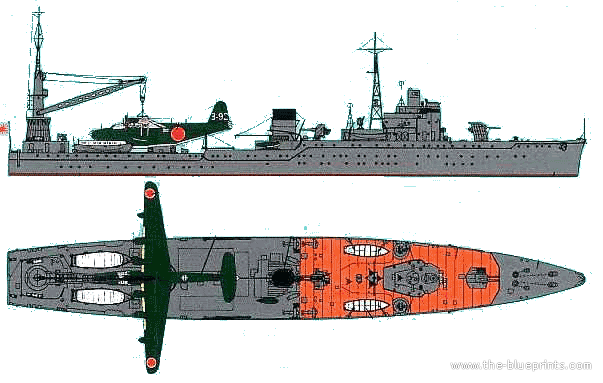
⚙ specifications |
|
| Displacement | 4,650 long tons (4,725 t) standard, 5,000 long tons (5,080 t) trial |
| Dimensions | 114.8 x 15.8 x 5.4m (376 ft 8 in x 51 ft 10 in x 17 ft 9 in) |
| Propulsion | 2 shafts Mk.22 Model 10 diesels, 4× Kampon boilers, 8,000 bhp (6,000 kW) |
| Speed | 19.0 knots (35.2 km/h; 21.9 mph) |
| Range | 8,000 nmi (15,000 km; 9,200 mi) at 14 kn (26 km/h; 16 mph) |
| Armament | 4× 5-in/40 Type 89, 4× Type 96 25mm AA, 6× Type 95 DCs, Type 94 Y-gun |
| Protection | None |
| Sensors | None |
| Air Group | 1 × flying boat in anchorage only |
| Crew | 545 |
Construction
Hull 131 Akitsushima was laid down at Kawasaki Shipbuilding, in Kōbe on 29 October 1940. She was launched on 25 July 1941, comp. 29 April 1942.
Hull 303 Chihaya was from the same yard, laid down on 25 July 1941. Construction was stopped in Autumn 1942 and she was later scrapped.
Hulls 5031, 5032, 5033 were not attributed any yard and construction was never ordered, instead they were cancelled on 5 May 1944.
Career of IJN Akitsushima
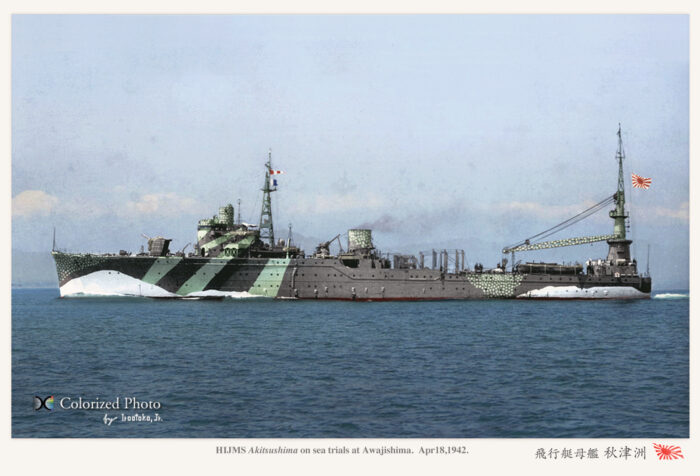
Wonderful colorization by irootoko JR. Note the fancy camouflage, one of the most original and complex for any IJN warship in WW2. This is also her open source unique photo
During her sea trials off Wadamisaki, Kobe, Japan, on 21 April 1942 after the Doolittle Raid (18 April) while on high alter, she opened fire on an approaching Japanese transport plane that was mistook for a B-25 Mitchell bomber. Splinters struck also the nearby passenger ship Tennyo Maru, which recoignise the plane and tranmitted an urgent report to the tender.
Akitsushima was eventually commissioned on 29 April 1942 and assigned to the 25th Air Flotilla, 11th Air Fleet, then two weeks later she sailed to Saipan and from there to Rabaul. Next she was sent to Shortland Islands on 16 August 1942 for the Guadalcanal Campaign. She was damaged by B-17E Flying Fortress while off Buka Island, two weeks later.
Repairs were completed on 5 January 1943, and she was sent to Kavieng, via Jaluit Atoll in February. On 30 June 1943 she was sent way north in the Aleutians, at Paramushir, for the evacuation of Kiska. She was back to Yokosuka in August. She then sailed via Shanghai to Truk. She was attacked and damaged (lightly) after a carrier raid as part of Operation Hailstone. In September she was assigned to the 14th Air Fleet and was repaired in Yokosuka also received repair ship facilities since the only specialized seplane repair ship Akashi was just sunk. This refit was completed on 1 August 1944 and she was assigned to the 2nd Fleet.
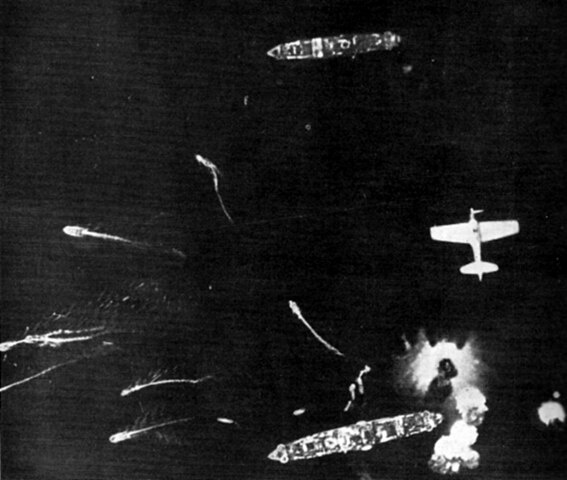
Tolonei Harbour attack, USN archives, Akistushima is not seen here unfortunately.
In August 1944, and she sailed for Kure and Imari, and then to Kaohsiung and Manila, until proceeding to Coron Bay, arriving on 23 September 1944. Sshe was sunk there by a raid from Task Force 38 on the 24th and officially struck from the Naval register on 10 November 1944.
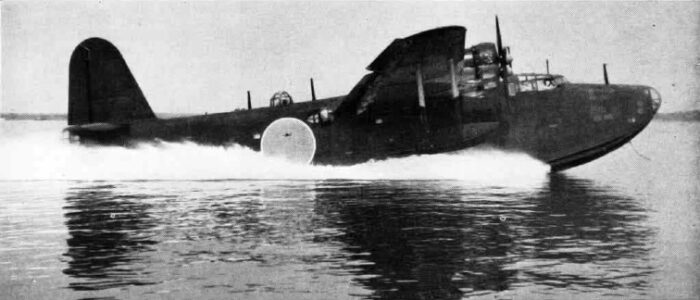
H8K taking off

The Kawanishi H6K in flight
Read More/Src
Books
History of Pacific War Vol.62, Ships of The Imperial Japanese Forces, Gakken (Japan), January 2008
Model Art Extra No.537, Drawings of Imperial Japanese Naval Vessels Part-3, “Model Art Co. Ltd”.
Collection of writings by Sizuo Fukui Vol.7, Stories of Japanese Aircraft Carriers, “Kōjinsha”. (Japan), August 1996
Ships of the World special issue Vol.40, History of Japanese Aircraft Carriers, “Kaijinsha”., (Japan), May 1994
The Maru Special, Japanese Naval Vessels No.25 Japanese seaplane tenders, “Ushio Shobō”. (Japan), March 1979
William Green: War Planes of the Second World War. Band 5: Flying Boats. MacDonald, London 1969.
Terasaki Ryuji et al.: Aufzeichnung der Kämpfe der Hilfsschiffe, Shobo Kojinsha, 2016
Takamatsu Nobuhito: Diary. Band 1–5. Chūō Koronsha, Tokyo 1997
Anthony J. Watts: Japanese Warships of the World War II. Ian Allan Publishing, Shepperton 1974
Hansgeorg Jentschura, Dieter Jung, Peter Mickel: Warships of the Imperial Japanese Navy 1869–1945. NIP
Kure Maritime Museum, Kazushige Todaka: Aircraft Carriers and Seaplane Carriers – Selected Photos, Kure Archives, NIP 2019
Links
navypedia.org/
pwencycl.kgbudge.com/ Akitsushima_class.htm
combinedfleet.com Strange ships cases
combinedfleet.com main menu auxiliaries
on facebook.com by erick navas
web.archive.org modelart.jp/
rekigun.net/
kojinsha.co.jp/
ships-net.co.jp/
Kawanishi_H8K
Kawanishi_H6K
Japanese_seaplane_tender_Akitsushima
http://www.coronwrecks.com akitsushima
pbase.com akitsushima



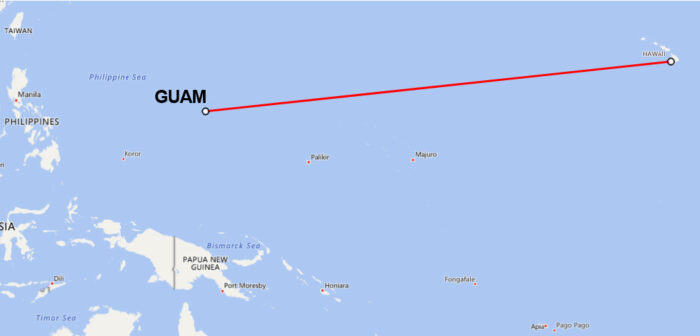
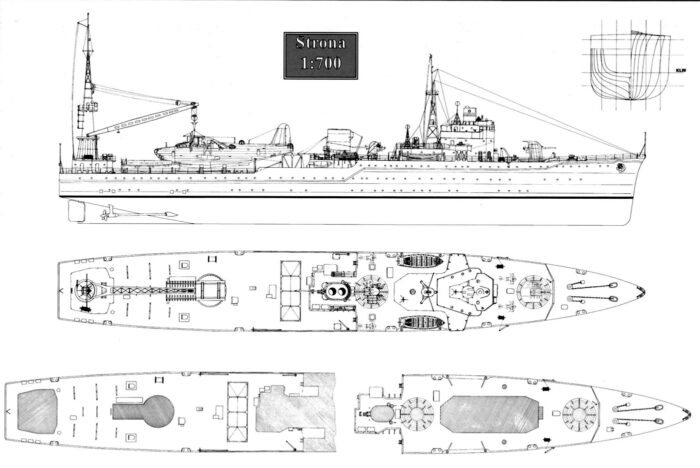


 Latest Facebook Entry -
Latest Facebook Entry -  X(Tweeter) Naval Encyclopedia's deck archive
X(Tweeter) Naval Encyclopedia's deck archive Instagram (@navalencyc)
Instagram (@navalencyc)





 French Navy
French Navy Royal Navy
Royal Navy Russian Navy
Russian Navy Armada Espanola
Armada Espanola Austrian Navy
Austrian Navy K.u.K. Kriegsmarine
K.u.K. Kriegsmarine Dansk Marine
Dansk Marine Nautiko Hellenon
Nautiko Hellenon Koninklije Marine 1870
Koninklije Marine 1870 Marinha do Brasil
Marinha do Brasil Osmanlı Donanması
Osmanlı Donanması Marina Do Peru
Marina Do Peru Marinha do Portugal
Marinha do Portugal Regia Marina 1870
Regia Marina 1870 Nihhon Kaigun 1870
Nihhon Kaigun 1870 Preußische Marine 1870
Preußische Marine 1870 Russkiy Flot 1870
Russkiy Flot 1870 Svenska marinen
Svenska marinen Søværnet
Søværnet Union Navy
Union Navy Confederate Navy
Confederate Navy Armada de Argentina
Armada de Argentina Imperial Chinese Navy
Imperial Chinese Navy Marinha do Portugal
Marinha do Portugal Mexico
Mexico Kaiserliche Marine
Kaiserliche Marine 1898 US Navy
1898 US Navy Sovietskiy Flot
Sovietskiy Flot Royal Canadian Navy
Royal Canadian Navy Royal Australian Navy
Royal Australian Navy RNZN Fleet
RNZN Fleet Chinese Navy 1937
Chinese Navy 1937 Kriegsmarine
Kriegsmarine Chilean Navy
Chilean Navy Danish Navy
Danish Navy Finnish Navy
Finnish Navy Hellenic Navy
Hellenic Navy Polish Navy
Polish Navy Romanian Navy
Romanian Navy Turkish Navy
Turkish Navy Royal Yugoslav Navy
Royal Yugoslav Navy Royal Thai Navy
Royal Thai Navy Minor Navies
Minor Navies Albania
Albania Austria
Austria Belgium
Belgium Columbia
Columbia Costa Rica
Costa Rica Cuba
Cuba Czechoslovakia
Czechoslovakia Dominican Republic
Dominican Republic Haiti
Haiti Hungary
Hungary Honduras
Honduras Estonia
Estonia Iceland
Iceland Eire
Eire Equador
Equador Iran
Iran Iraq
Iraq Latvia
Latvia Liberia
Liberia Lithuania
Lithuania Mandchukuo
Mandchukuo Morocco
Morocco Nicaragua
Nicaragua Persia
Persia San Salvador
San Salvador Sarawak
Sarawak Uruguay
Uruguay Venezuela
Venezuela Zanzibar
Zanzibar Warsaw Pact Navies
Warsaw Pact Navies Bulgaria
Bulgaria Hungary
Hungary

 Bundesmarine
Bundesmarine Dutch Navy
Dutch Navy Hellenic Navy
Hellenic Navy Marina Militare
Marina Militare Yugoslav Navy
Yugoslav Navy Chinese Navy
Chinese Navy Indian Navy
Indian Navy Indonesian Navy
Indonesian Navy JMSDF
JMSDF North Korean Navy
North Korean Navy Pakistani Navy
Pakistani Navy Philippines Navy
Philippines Navy ROKN
ROKN Rep. of Singapore Navy
Rep. of Singapore Navy Taiwanese Navy
Taiwanese Navy IDF Navy
IDF Navy Saudi Navy
Saudi Navy Royal New Zealand Navy
Royal New Zealand Navy Egyptian Navy
Egyptian Navy South African Navy
South African Navy






























 Ukrainian Navy
Ukrainian Navy dbodesign
dbodesign